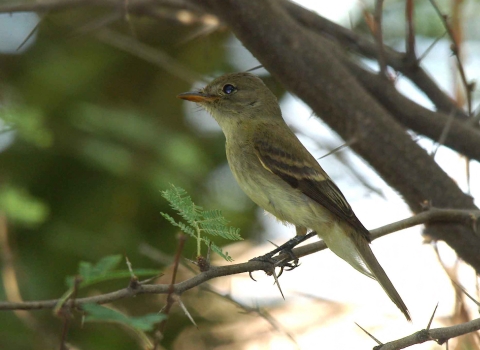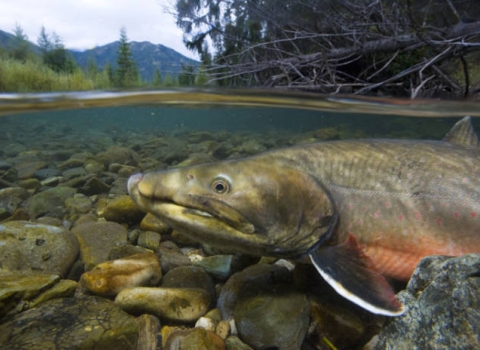The U.S. Fish and Wildlife Service today affirmed its commitment to building strong relationships, knowledge sharing, and empowering Tribes, Alaska Native Corporations, Alaska Native Organizations and the Native Hawaiian Community in the stewardship of public lands and waters by fulfilling the Service’s trust responsibility at every level of the agency’s work.
The Service’s Director’s Order 227 establishes a consistent national framework for guiding the organization as it relates to the agency’s unique trust responsibilities to Tribes and the Native Hawaiian Community in the stewardship of federal lands and waters and where Tribes have subsistence or other rights or interests. This framework provides flexibility to respond to regional and local variations in history, knowledge systems, ways of knowing, applicable laws, treaties and Service-Tribal relationships.
“When the Service and Indigenous peoples work together on stewarding our lands and waters, along with the fish and wildlife that inhabit them, our longstanding relationships are strengthened, and resources are better stewarded,” said Service Director Martha Williams. “The Service recognizes the need for strong, healthy communication and relationships with Tribal governments and communities so we can work together to improve and enhance our conservation mission. Service employees in every program and at every level who have official duties that may affect Tribal interests should coordinate at the earliest phases of work.”
In managing public lands and waters, the Department of the Interior (DOI) is charged with the highest trust responsibility to protect Tribal interests and further the nation-to-nation relationship with Tribes. The United States’ trust and treaty obligations are an integral part of the department’s responsibilities in managing federal lands. These guidelines for shared stewardship are a roadmap for how DOI will continue to address climate-related challenges and explore opportunities to improve resiliency and protect our lands and waters. The guidance will help further the directives from Joint Secretarial Order 3403 – signed by the secretaries of the Interior and Agriculture during the 2021 White House Tribal Nations Summit – which outlines how the two departments will strengthen Tribal co-stewardship efforts. The guidance also outlines how agreements might proceed with Alaska Native Corporations and the Native Hawaiian Community.
Recent examples of co-stewardship that are consistent with Director’s Order 227 include:
- A June 2022 New York State, Onondaga Nation and Service agreement that will return 1,000 acres of historic homeland to the Onondaga Nation. The transfer will include a conservation easement conservation easement
A conservation easement is a voluntary legal agreement between a landowner and a government agency or qualified conservation organization that restricts the type and amount of development that may take place on a property in the future. Conservation easements aim to protect habitat for birds, fish and other wildlife by limiting residential, industrial or commercial development. Contracts may prohibit alteration of the natural topography, conversion of native grassland to cropland, drainage of wetland and establishment of game farms. Easement land remains in private ownership.
Learn more about conservation easement that will protect wetlands, streams and other sensitive fish and wildlife habitat while supporting outdoor recreational and educational uses and public access. The Onondaga Nation will implement and manage restoration and stewardship of natural resources in accordance with Traditional Ecological Knowledge, cultural, spiritual, and educational practices in consultation with the Co-Trustees. - A February 2022 465-acre conservation easement within the Fones Cliff area, now part of Rappahannock River Valley National Wildlife Refuge, via donation. The federally recognized Rappahannock Tribe holds the underlying fee. The Tribe has restored the land to its original name of Pissacoak, after one of the three Rappahannock towns on the white clay river cliffs. The Tribe considers Fones Cliff to be a sacred site, home to their ancestors for thousands of years and the site of key encounters with the English. The easement’s conditions protect wetlands and prohibit development, while allowing for other uses of the property, including investigating archeological resources, and promoting cultural learning. See https://www.fws.gov/story/2022-04/return-river
- A June 2022 Memorandum of Understanding (MOU) with three federally recognized Tribal Nations who seek a secure, respectful location on federal lands in the Delaware River Basin for the reburial of ancestral remains repatriated to the Tribes via the Native American Graves Protection and Repatriation Act (NAGPRA). The Lenape National Wildlife Refuge Complex has been working with three Tribes, which all share Lenape ancestry; the Delaware Nation and the Delaware Tribe reside in Oklahoma, and the Stockbridge-Munsee Community in Wisconsin. The Service is offering the Tribes a reburial site at Cherry Valley National Wildlife Refuge, part of the Lenape NWR complex, in Stroudsburg, Pennsylvania. The MOU will guide the reburial process and the future operational relationship between the Service/Refuge and the Tribes. The next step in this agreement is for Tribal representatives to visit Cherry Valley NWR to view the potential reburial locations and make a selection.
- In June 2021, Kodiak National Wildlife Refuge took a step to strengthen its partnership with Koniag, Inc., an Alaska Native Claims Settlement Act Corporation, by entering into a Title I Indian Self Determination and Education Assistance Act contract to support a new Community Affairs Liaison position. The new Community Affairs Liaison will serve a critical role in enhancing communication and education programs and services between the Service and Alaska Native stakeholders through the Kodiak Archipelago. In funding this new position, the Service is recognizing and supporting Koniag’s deep cultural and historic ties in the region to meaningfully contribute to and enhance the Service’s relationships and communications in the region. This is the first Title I contract for the Service, and the first with an Alaska Native Corporation.
For more information about the Director’s Order, please see https://www.fws.gov/media/directors-order-no-227
The U.S. Fish and Wildlife Service works with others to conserve, protect, and enhance fish, wildlife, plants, and their habitats for the continuing benefit of the American people. For more information, visit www.fws.gov, or connect with us through any of these social media channels: Facebook, Twitter, Flickr, and YouTube.


